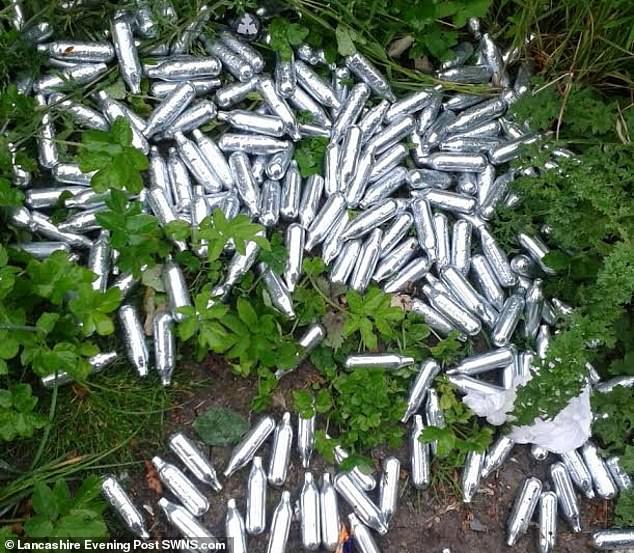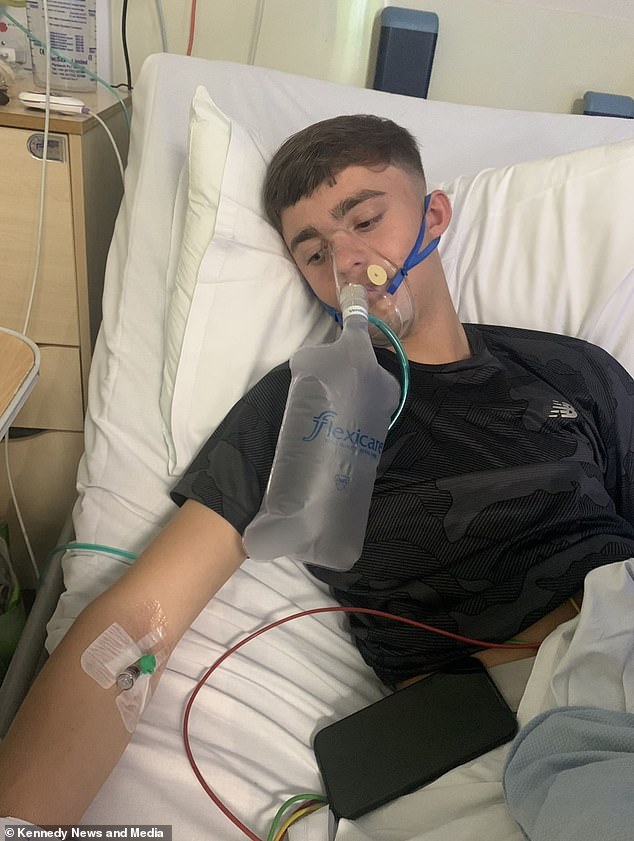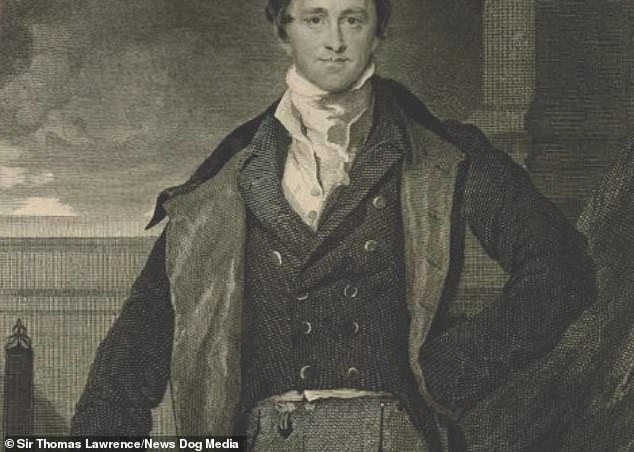How ‘hippy crack’ became kids’ drug of choice – and why it’s fallen out of favour with Gen Z

It was once loved by rebellious teenagers seeking a cheap, quick high, as well a swatch of famous faces and footballers.
But now nitrous oxide – sometimes called ‘laughing gas’, ‘hippy crack’ or ‘nos’ – is quickly going out of fashion. Usage rates have halved in the wake of the pandemic, official figures suggest.
The downturn comes amid a spate of deaths linked to the substance, sold in little silver cannisters that litter the streets, and typically inhaled though a balloon just like helium.
Business student Ellen Mercer, 24, from Gerrards Cross, Buckinghamshire, became the latest confirmed casualty of nitrous oxide use. Yesterday an inquest heard how Ms Mercer, who died in hospital last February, was ordering huge bottles of the drug up to three times a day.
Some former addicts have shared how they went through up to 500 cannisters in a weekend, describing it as ‘more addictive than cocaine’.

Coroner Heidi Connor listed ‘long term complications due to nitrous oxide abuse’ among the causes of Ellen Mercer’s (pictured) death
As well as deaths, serious side effects including dizziness, weakness in the legs and impaired memory are thought to have discouraged today’s kids from experimenting with nitrous oxide.
Hippy crack, which creates a temporary feeling of relaxation and euphoria, rose to modern notoriety in the early 2010s.
Balloon-wielding dealers cashed in on demand, partly fuelled by a glamorous array of celebs and footballers posting images of themselves apparently using it.
TOWIE‘S Jessica Wright faced criticism for posting a picture of herself apparently using a hippy crack balloon in 2013.
Coronation Street actress Michelle Keegan was spotted taking the drug in 2012 at London’s Anya nightclub as part of her 25th birthday celebrations.
Even Prince Harry who was seen indulging in nitrous oxide once at a charity fancy-dress party party in 2010 in the capital.
As recently as 2021, former Love Island start Jack Fincham was spotted seemingly inhaling hippy crack at a party with friends.
Manchester City’s Jack Grealish and Chelsea’s Raheem Sterling have also drawn criticism for taking hippy crack over the years.
TV star Trisha Goddard‘s daughter Billie Dee shared the impact of her massive nos addiction last year.
‘It’s more addictive than any other drug I’d known and I was taking one after the other after the other, sometimes doubling up with two canisters in one balloon. I’d spend all weekend in the flat, easily getting through 500 in two days,’ she said.
‘I wasn’t looking after myself, not eating properly and even forgetting to drink water some days,’ she says.
‘I didn’t even have the cognitive function to answer my phone.’
Another factor that experts believe fuelled its popularity is how cheap it is to buy, with cannisters of the gas sold online for as little as 20p each.
Each cannister is enough to fill a single balloon, though larger models can fill up to 80.
Balloons are then consumed in ‘gulps’ by either a single person or a group typically over a short period.

Billie Dee would turned to the cheapest way she knew to unwind – inhaling nitrous oxide, or ‘nos’, from balloons
While suppliers often mark this up to £5 or more per balloon at festivals and night clubs, it’s still cheaper than a pint of beer in many parts of the country — let alone other recreational substances.
And the fact it also has a legitimate use in the food industry, as well as in medicine, meant it was relatively easier to get a supply than other, harder drugs.
However, hippy crack’s time as a top drug among young people is over.
Data from the Office for National Statistics (ONS) shows just 4.2 per cent of 16-to-24 years olds, equivalent to about 250,000 people, used nitrous oxide between 2022-23.
While this still puts nitrous oxide well above the likes of ketamine, LSD and ecstasy (3.8, 1.5 and 2.4 per cent, respectively), it is a 54 per cent decline on previous figure.
Almost one in 10 (8.7 per cent) or about 500,000 young people used nitrous oxide in 2019-20, the most recent year of data unaffected by the Covid pandemic.
Cocaine has seemingly overtaken hippy crack in popularity among Gen Z, with nos now in third place.
Just over one in 20 youngsters (5.1) consumed cocaine within the last year.
Cannabis remains the most popular drug overall among young people, a position it has held since the 90s.
Many think of nitrous oxide as harmless, especially when compared to other illicit substances like cocaine, ketamine and ecstasy.
But experts warn this is a misconception and that recreational use of nitrous oxide is dangerous.
Heavy and regular recreational use of the substance can lead to dizziness, weakness in the legs and impaired memory.
Roughly 40 per cent of users have reported suffering side effects such as anaemia, cognitive impairment and chronic headaches.

Neurologists have warned that nitrous oxide, a gas inhaled recreationally by some young people, is more dangerous than cocaine. Pictured: Revellers suck on balloons at a music festival, a common way people inhale nitrous oxide

Nitrous oxide, also known as hippy crack or nos, is sold in distinctive silvery canisters which have become a common sight discarded on streets and parks in some parts of the UK
It can even cause users to faint or suffocate due to the temporary lack of oxygen to the brain, if they inhale highly concentrated forms of the gas.
Vitamin B12 depletion, a complication triggered by abusing nitrous oxide, can also cause neurological problems. One man was left brain damaged after inhaling 2litres of laughing gas ever week for six months.
Some neurologists have reported seeing more patients damaged by hippy crack than cocaine nowadays. Addicts have told of using up to 150 cylinders per day.
The exact reason for the downturn in hippy crack usage among young people in the most recent data is unclear.
Multiple horror stories of injuries and even deaths linked to nitrous oxide, may have scared a significant portion of Gen Z off the drug.
Such cases include business student Ellen Mercer, 24, from Gerrards Cross, Buckinghamshire who died after inhaling three large bottles of nitrous oxide in February of last year.
Other include London receptionist Kerry Donaldson, who warned of the effects of long-term nitrous oxide in 2022.
A previous heavy user of hippy crack in 2017, she began to lose sensation in her hands and is now partially paralysed.
She now has to use a wheelchair to get around after developing a disc bulge in her lower back and nerve damage.

Kerry Donaldson (pictured), 25, from Newham in London, revealed in July 2022 how her ‘hippy crack’ binges damaged her spinal cord and forced her to rely on her dad for round-the-clock care

Alex Littler (pictured), from Cheshire, was just 16 when he was rushed to hospital on June 20 2022 last year after inhaling nitrous oxide
Kerry, 25 at the time, said in 2022: ‘I didn’t really understand the damage that it could cause. I just thought it was a bit of fun, I didn’t think it would harm me.’
That same year, 16-year-old Kayleigh Burns collapsed at a house party in Leamington Spa.
The teenager, who was asthmatic, had taken laughing gas shortly before she complained of being ‘too hot’, before falling unconscious.
She was rushed to hospital, where she later died.
Also in 2022, Alex Littler, 16, almost died after inhaling nitrous oxide at the Parklife festival last year.
He was rushed to hospital after complaining of a swollen neck, but it emerged that he had a ruptured and leaking lung and was lucky to be alive.
Another factor that could have contributed to the decrease in usage was Government promises of a crackdown which became reality in October of last year.
Under the change, hippy crack became a a controlled Class C drug, similar to some steroids and anti-anxiety medications benzodiazepines such as Valium.
It means dealers of nitrous oxide could face up to 14 years in jail.

Sir Humphry Davy depicted in. 1830 Humphry Davy was a chemist who discovered the pleasurable effects of ‘hippy crack’ in 1799
Users also face an unlimited fine, community service, a caution – which would appear on their criminal record – or a possible two-year sentence for serious habitual users.
Nitrous oxide use will remain lawful for catering purposes and medical use.
While licences will not be needed to carry nitrous oxide, users will be required to demonstrate they’re not intending to consume it for psychoactive effects.
Hippy crack isn’t a new phenomenon. Recreational use dates back to 1799, following the drug’s discovery.
Then ‘laughing gas parties’ were popular among segments of Britain’s upper class.
The trend was launched by then twenty-year old chemist Humphry Davy – later to become Sir Davy, president of the Royal Society – after he began experiments on himself in Bristol to determine the medical effects of inhaling nitrous oxide.
During his experiment, Davy was pleased to find the gas offered euphoric effects – and was highly pleasurable ‘particularly in the chest and extremities’.
Davy went on to introduce the gas to his friends while also noting that it alleviated pain he was suffering from a toothache, a discovery that eventually led to its use in medicine.




